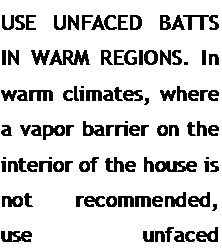Materials RIGID-FOAM INSULATION
LIGHT, FAIRLY INEXPENSIVE, and easy to cut and Rigid-foam insulation gives you more flexibility install, rigid-foam insulation has a lot going for it. in meeting code requirements. Used in conjunction This insulation board comes in different thicknesses with high-density R-15 fiberglass batts in a 2×4 and sheet sizes. Depending on the manufacturer, wall, rigid foam can bring the R-value of a 2×4 wall it comes in shades of blue, green, and pink. A up to that of a 2×6 wall with standard R-19-rated Yz-in.-thick sheet is rated at R-3; a 1-in. sheet is fiberglass (without the expense of wider framing). If rated at R-5. you can afford it, adding rigid foam to the exterior
Exterior Use. Rigid foam is often used on build – of a 2×6 wall creates an even more energy-efficient ing exteriors. In regions where there is no danger house and lower utility bills, of earthquakes or hurricanes, foam sheets are fre – There are two important considerations if you’re quently used in place of wall sheathing. With this sheathing a house exterior with foam insulation, type of installation, sheets of plywood or OSB are First, some types of exterior siding (wood shingles still required at the corners of the house and every and clapboard, for example) are best installed over 25 ft. to provide lateral bracing for the structure; solid backing rather than over foam board. Second, however, foam boards are used between the corner if you’re installing rigid foam over plywood or OSB sheets and are nailed directly to the studs (see sheathing, make sure the jambs for the doors and chapter 6). Taping the seams between the sheets windows you order are wide enough for the wall, improves the foam’s performance as a wind barrier. Standard-width jambs may be too narrow.
I like to use foam insulation on the exterior of Installing the Foam. Working with rigid foam framed walls, because up to 25% of a wall’s area is simple. It cuts easily with a utility knife. To nail can consist of solid wood—studs, headers, trim – sheets to the wall, I use either 1%-in. roofing nails mers, and so on. Wood acts as a thermal bridge, or nails with plastic heads, which are used to secure allowing heat or cold to be conducted through a felt paper to the roof deck. In windy areas, I like wall. Rigid foam helps block this conduction. to nail about 12 in. o. c. around the edges and Sheathing with 4-ft. by 9-ft. foam panels enables 24 in. o. c. in the field. Make sure you fit the sheets you to cover a standard-height wall and the rim together tightly.
Y4
joist below it.
|
isn’t very helpful. In fact, doing so just eliminates much of the air space within the material, effectively reducing its value as insulation. There are a number of materials used for insulation, but the three most common ones are cellulose, rigid foam, and fiberglass. Subcontractors most often install cellulose insulation by blowing the loose material into attics with special equipment (see the sidebar on p. 199). When binders are added to cellulose insulation, it can also be sprayed in dampened form between studs. When it is |
|
properly applied, the insulation stays in place after the moisture evaporates. Unlike fiberglass insulation, which demands careful installation to avoid gaps and air pockets, cellulose fills voids effectively, thanks to gravity (when blown into an attic) or air pressure (when blown into stud bays). Rigid foam is often installed as insulation beneath concrete slabs and as sheathing panels beneath exterior siding (see the sidebar above). But fiberglass is still the most common type of insulation used in this country |


today. Affordable and available everywhere, fiberglass insulation does a good job when it’s installed properly (see the sidebar on p. 199).






Leave a reply